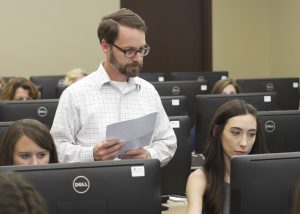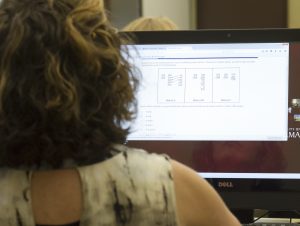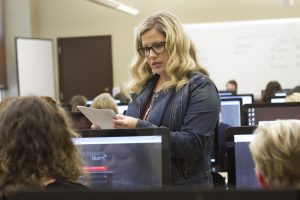
Two minds are better than one.
That’s the thinking behind a trend in elementary education called “co-teaching,” a method in which general education and special education teachers work collaboratively to increase their content knowledge and provide engaging math instruction for students.
Since 2015, University of Alabama education and math researchers have worked with nearly 30 teachers from eight Tuscaloosa County elementary schools to help implement some of the foundations of co-teaching into their classrooms, like thorough planning and debriefings and defined roles and responsibilities while teaching together.
The project is funded by a $1 million grant from the Math-Science Partnership through the United States Department of Education and Alabama Department of Education. Researchers and area teachers held their final professional development session Tuesday at The University of Alabama.
“Most of the time, when people think about math, they think about doing arithmetic,” said Abby Mills, fourth grade general education teacher at Englewood Elementary. “Sometimes, giving students open-ended, more higher-quality tasks can lead students into out-of-the-box thinking in mathematics.
“It can lead students into problem-solving in mathematics, more critical-thinking skills, which they don’t always get the opportunity to do in the classroom.”
Researchers say the benefits for students are numerous, especially for special education students.

Hope Bailey, a special education teacher at Englewood Elementary, works a math problem in a web portal Tuesday at Graves Hall.
“There’s research that shows children with disabilities benefit from being in a classroom with grade-level kids,” said Dr. Stefanie Livers, UA assistant professor of elementary mathematics education.
“They hear the dialogue and conversation versus always being pulled out for instruction where there is very limited mathematical language. This leaves struggling students feeling inferior and ultimately thinking ‘how am I ever going to speak about mathematics or do mathematics like the rest of the class?’”
Livers and University of Alabama researchers Dr. Jim Gleason, principal investigator of the grant and an associate professor in UA’s department of mathematics; Dr. Kristin Harbour, assistant professor, elementary mathematics education; and Dr. Sara McDaniel, associate professor, special education; are seeking a third year of funding to further track implementation of the co-teaching model in the schools and to see which components will sustain.
The findings so far have been encouraging. Livers said data shows upward shifts in student engagement and improvements in classroom management.
Additionally, they’ve noticed increased math content knowledge of both special education and general education teachers, a key component in an over-arching goals of the grant to decrease the mathematics achievement gap of special education students.
Still, every school is different in how it’s progressing with co-teaching principles, Livers said.
“With co-teaching, where there was none, we’re now shifting to more collaboration,” Livers said. “One teacher said they’d added another teacher (outside of their grant participants), and the special education teacher is comfortable co-teaching.
“Some have done presentations at their faculty meetings, which is what we push for. In one school, the two teachers in the grant no longer work together day to day, but they will still come to our sessions and co-teach together.”
Inside the model
As mathematics standards and curriculum have evolved in recent years, so has instruction, which is moving from scripted procedural work to critical thinking and high-quality tasks.

The goal is to move away from workbooks to tasks that can be differentiated, even if students are completing fewer problems and working on a math concept for multiple days, Livers said. Students can be split into groups to address individual areas of need, all while solving within the same context.
“You’re actually working less hard, because here’s your one task for a situation to investigate, and then you can tweak it for each group,” Livers said. “We’ve seen our teachers be more creative in how they structure the lesson and realize everyone doesn’t have to do the same thing at the same moment.
“As a result, students are doing computation, problem-solving and talking to each other instead of silently sitting and doing problems.”
Co-teaching aids in this transition by allowing teachers to work to their strengths and group students by their needs, instead of addressing the entire class at one time.
Still, the idea of co-teaching is relatively new and can be complicated for schools that have fewer special education teachers.
The model also challenges teachers’ scheduling and teaching dynamics, but, when executed well, teachers in the grant have discovered that sharing different parts of a lesson can help them teach to their strengths and differentiate instruction in an inclusive classroom.
“You have to be willing to open yourself up and be vulnerable with another teacher,” said Sylvie McDonald, fifth grade special education teacher at Englewood, “but, through the experience, you’re a stronger, more effective teacher because of it, and you have a teammate that’s the same way.
“It’s a struggle, at first, to find that balance. But it’s worth it in the end when it’s all running smoothly.”
McDonald said teachers have intervention times and use formative and summative assessments to measure progress. Special education teachers’ workloads, from paperwork to implementing individualized education plans, can dictate how much time they can dedicate to planning and debriefing with general education teachers.
“We have forms to debrief with — to talk about what went well,” Mills said. “We focus on the areas to work on in the areas of high-quality mathematics, differentiation and our co-teaching so we can have those informal conversations with one another about ‘we thought the mathematics was good in this lesson, but we could have co-taught it a different way,’ or, ‘we did this activity, but those who struggled could have used this differentiation.’”
Goals and expectations
Predicating which schools will sustain the components of the grant and which parts they’ll continue to incorporate into planning and instruction is difficult, Livers said.
Livers and Harbour both co-taught when they were K-12 teachers and believe the challenges to teachers and administrators are worth the outcome of increased academic achievement. Co-teaching allows teachers greater flexibility to analyze their curriculum and determine if it’s impactful for all of their students, or if it’s merely scratching the surface, Livers said.
After seeing her students at Englewood have success, McDonald said she can’t imagine not co-teaching.
“Going through the program has encouraged me as a teacher and opened up my eyes to that type of mathematics,” Mills added, “and, also how to effectively use a co-teacher in the classroom, and what it looks like. It’s more than just one teacher teaching and another teacher helping – it’s that two teachers can deliver all levels of instruction.”